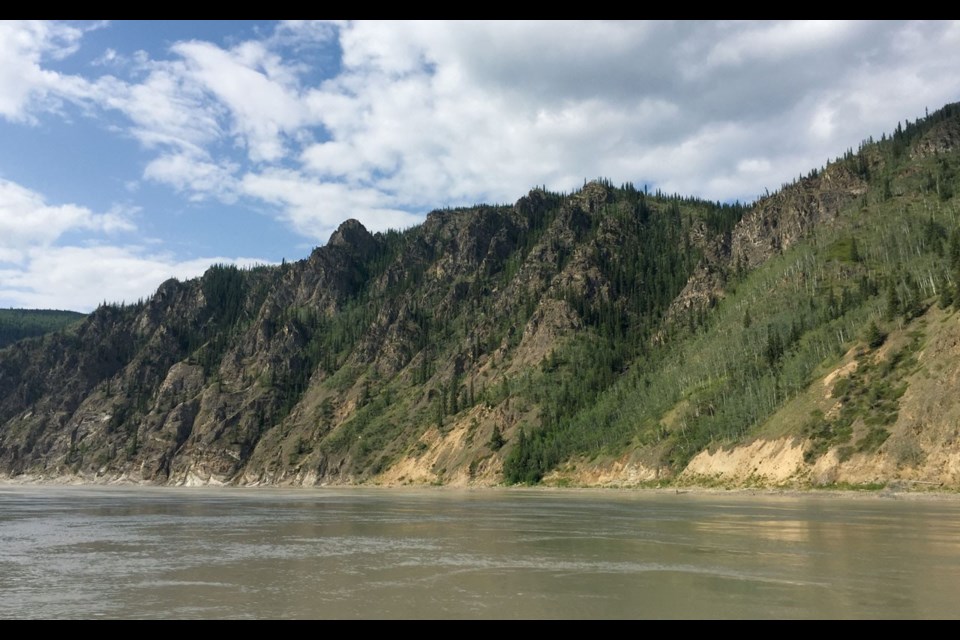Paddling the Yukon River, it's sounds that strike you first. To start, a constant, pervasive fizzing suggests air leaking from a tire. In a raft it might be panic-inducing, but in a canoe we're not sure what to think until guides Colm and Andy of Castlerock Canoe and Klondike River Rafting explain that it's silt striking the hull. Given the sediment-filled valley it wanders, the Yukon is an unapologetically gritty river—coloured like weak coffee with skim milk—its hiss intensifying over upwellings that stir extra silt from the bottom. At first disquieting, it soon becomes oddly comforting.
The next aural question is echoes, whose answer lies in the many places the river is pinched by bluffs—even where these are kilometres from the sound source. This also explains why even the tiniest gurgling side-stream is amplified into a roaring Niagara.
While our heads swivel like dogs in an arcade, Colm and Andy remain nonplussed, having tracked this 76-kilometre route from Dawson City to the pullout at 40 Mile many times. Andy, a Yukoner of six years originally from Quebec, loves her adopted home, despite its city-like strain on personal resources—the cabin she rents in Dawson at Whistler-esque prices has no water or electricity. Small, wiry and unperturbable, Colm has river guided 20 years but done many other things including placer gold mining; when I ask where the Yukon's gold originated, he says no one knows, it's all still theory. It clearly eroded from uplifted rock, as gold-rich gravels found at higher elevations have further washed into valleys, but Pleistocene ice sheets may have erased these original ore veins from the land.
Much human history has also been erased here. We pass a ship graveyard where abandoned paddlewheelers are heaped on shore, many hidden by trees. To our right is the dwindling First Nations community of Moosehide, on the left an island farmed by a British couple whose enormous dogs threaten from the shore; then Sisters Island, where nuns once grew vegetables to supply Dawson's Catholic hospital, and Dog Island where sled dogs are still raised. Beyond these, half an hour after leaving Dawson, we're paddling through the Middle of Nowhere, our only companion the restless river.
Since the last Ice Age, when it formed a corridor by which many species of plants and animals—and possibly humans—infiltrated the continent's interior, the Yukon has drained the Canadian subarctic in a 3,200-kilometre journey across Alaska to where its gigantic delta meets the Bering Sea. As rivers go, it's massive and magnificent, though words can't truly describe its scale; where the Yukon braids around large, wooded islands, channels can be wider than the mighty Fraser. Getting to one side of the watercourse requires planning kilometres in advance, especially when winds throw up metre-high swells to mix with the river's 10 to 14 kph current, whirlpools, boils and frequent strong eddy lines. Though rapids are rare and confined to low-water at this point, we still manage a few short-lived thrills. Gravel bars and mudbanks constantly surprise from beneath the opaque surface, and it's easy to see why navigating this shifting sub-aqueous landscape was so difficult even for the shallow-drafted paddlewheelers plying the river during the Klondike Goldrush.
Alternating cliffs and mountainsides bookend the flats of tributary deltas where clear-water confluences once hosted mining towns and riverboat stops like Silver City, DeWolfe's Halfway House, and Cassiar House, now consigned only to names in history books. After four hours, we stop for lunch at the end of a long island, where wind whips up mini-sandstorms and bear and moose tracks crisscross shoreline mud that wobbles like jelly when you walk on it.
It's genuinely and surprisingly hot in the sun, and warm enough in the shadows thrown by passing clouds that the outsized nature of our mission—completing what is usually a two-day paddle in a mere one—seems more acceptable than if it were storming. Nevertheless, a heinous wind blows in our faces when the river turns north, strong enough to obviate most of the help we're getting from the current. Fortunately these spells don't last more than the half-hour it takes to reach another turn in the river.
Still, the Yukon presents a world of wonders. At one point we see a small grizzly swimming the river, and, in the final canyon, columns of smoke curl skyward from a ghost fire burning through tree roots and ground peat since last year. Now fatigued, end-of-the-day blues see us rounding point after point hoping for a landing that never seems to come.
Finally, after 10 hours on the water, we arrive at 40 Mile, the Yukon's oldest town. Established in 1886 by prospectors and authorities looking to shore up Canada's border with Alaska, the site was variously inhabited by Indigenous peoples for 2,000 years before Europeans threw up saloons, pool rooms, library, an opera house, and, still standing today, a Royal North-West Mounted Police barracks, general store, Anglican mission, and telegraph office.
As we walk the historic townsite, abandoned during the upstream Klondike Goldrush and now co-managed by Tr'ondëk Hwëch'in and the Yukon government, we hear the one sound that has eluded us all day: silence.
Leslie Anthony is a Whistler-based author, editor, biologist and bon vivant who has never met a mountain or a river he didn't like.




